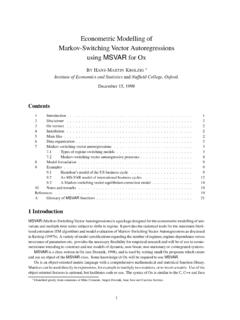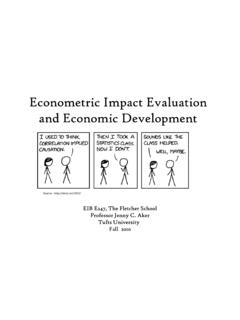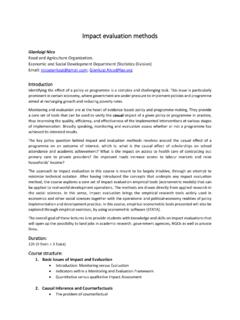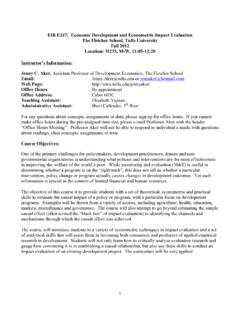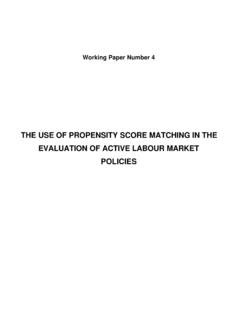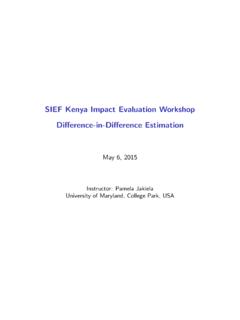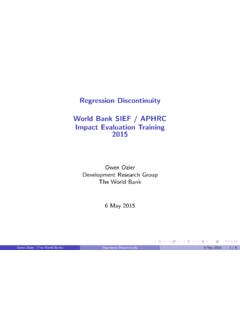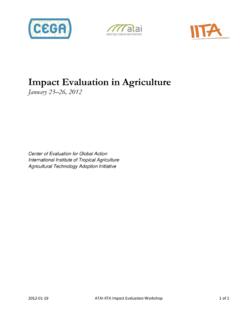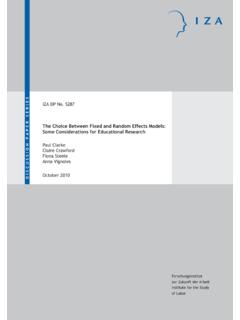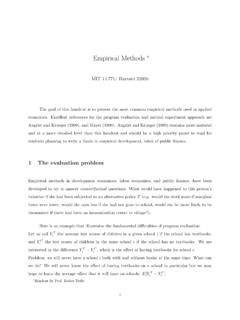Transcription of Implementing Propensity Score Matching Estimators with …
1 1 Implementing Propensity Score Matching Estimatorswith STATAB arbara SianesiUniversity College LondonandInstitute for Fiscal StudiesE-mail: forUK stata Users Group, VII MeetingLondon, May 2001 2 BACKGROUND: THE evaluation PROBLEMPOTENTIAL-OUTCOME APPROACHE valuating the causal effect of some treatment on some outcome Yexperienced by units in the population of the outcome of unit i if i were exposed to the treatmentY0i the outcome of unit i if i were not exposed to the treatmentDi {0, 1} indicator of the treatment actually received by unit iYi = Y0i + Di (Y1i Y0i) the actually observed outcome of unit iX the set of pre-treatment characteristicsCAUSAL EFFECT FOR UNIT iY1i Y0iTHE FUNDAMENTAL PROBLEM OF CAUSAL INFERENCE impossible to observe the individual treatment effect impossible to make causal inference without making generallyuntestable assumptions3 Under some assumptions:estimate the average treatment effect at the population, or at a sub-population, level.
2 Average treatment effect average treatment effect on the untreated AVERAGE TREATMENT EFFECT ON THE TREATED:E(Y1 Y0|D=1) = E(Y1|D=1) E(Y0|D=1)Need to construct the counterfactual E(Y0 | D=1) the outcomeparticipants would have experienced, on average, had they (Y0 | D=0) ?In non-experimental studies:need to adjust for confounding variables4 Matching METHOD1. assume that all relevant differences between the two groups arecaptured by their observables X: (A1)2. select from the non-treated pool a control group in which thedistribution of observed variables is as similar as possible to thedistribution in the treated groupFor this need:(A2) Matching has to be performed over the common support regionPROPENSITY Score MATCHINGp(x) Pr{D=1|X=x}A1) & A2) Y0 D | p(X) for X in ~ 0 < Prob{D=1 | X=x } < 1 for x ~ Y0 D | X5 OVERVIEW: TYPES OF Matching Estimators pair to each treated individual i some group of comparable non-treated individuals and then associate to the outcome of the treated individual i, yi, the(weighted) outcomes of his neighbours j in thecomparison group:6()ywyiijjjC pi= 0where.
3 C0(pi) is the set of neighbours of treated i in the control group wij [0, 1] with wijjC pi =01()is the weight on control j in forming a comparison with treated iTwo broad groups of Matching estimatorsindividual neighbourhoodweights6 Associate to the outcome yi of treated unit i a matched outcomegiven by1. the outcome of the most observably similar control unit TRADITIONAL Matching Estimators :one-to-one matchingCpj ppppiijkDik00():|| min{||}{}= = = wik = 1(k=j)2. a weighted average of the outcomes of more (possibly all) non-treated units where the weight given to non-treated unit j is inproportion to the closeness of the observables of i and j SMOOTHED WEIGHTED Matching Estimators :kernel-based matchingC0(pi) = {D=0}(for gaussian kernel)wpphijij KK(.) non-negative symmetric Propensity Score Matching Estimators WITH STATAP reparing the datasetKeep only one observation per individualEstimate the Propensity Score on the X via probit or logitand retrieve either the predicted probability or the indexNecessary variables: the 1/0 dummy variable identifying the treated/controls the predicted Propensity Score the variable identifying the outcome to be evaluated [optionally: the individual identifier variable]8 ONE-TO-ONE Matching WITH REPLACEMENT(WITHIN CALIPER) Nearest-neighbour matchingTreated unit i is matched to that non-treated unit j such that:||min{||}{}ppppijkDik = = 0 Caliper matchingFor a pre-specified >0, treated unit i is matched to that non-treatedunit j such that.
4 > = = ||min{||}{}ppppijkDik0If none of the non-treated units is within from treated unit i,i is left psmatch treated, on( Score ) cal(.01)[id(serial)] [outcome(wage)]Creates:1) _times number of times useduse _times as frequency weights to identify the matched treated andthe (possibly repeatedly) matched controls2) _matchdif pairwise difference in Score . sum _matchdif, det for Matching qualityIf id(idvar) specified3) _matchedid the idvar of the matched controlIf outcome(outcomevar) specified: directly calculates and displays:Mean wage of matched treated = wage of matched controls = = err = : takes account of possibly repeated useof control observations but NOT ofestimation of Propensity for H0: effect=0 is .7758105310 KERNEL-BASED MATCHINGI deaassociate to the outcome yi of treated unit ia matched outcome given by a kernel-weighted average of theoutcome of all non-treated units,where the weight given to non-treated unit j is in proportion to thecloseness between i and j:6{}{}yKpphyKpphiijjjDijjD= = = 00 Control j s outcome yj is weighted bywKpphKpphijijijjD= = {}0 Option smooth(outcomevar) creates:_moutcomevar the matched smoothed outcomevar 6yi11 Bandwidth h selectiona central issue in non-parametric analysis trade-off bias-variabilityKernel K choice GaussianKuu( )exp(/ ) 22uses all the non-treated units.
5 Psmatch treated, on( Score ) cal( )smooth(wage)Mean wage of matched treated = wage of matched controls = = EpanechnikovKuu() () 12 if |u|<1 (zero otherwise)uses a moving window within the D=0 group, those non-treated units within a fixed caliperof h from pi: |pi pj| < h. psmatch treated, on( Score ) cal( ) smooth(wage)epan12 Common supportif not ruled out by the option nocommon, common support isimposed on the treated units:treated units whose p is larger than the largest p in the non-treatedpool are left psmatch treated, on( Score ) cal( ) smooth(wage) [epan] nocommon13 SMOOTHING THE TREATED TOOFor kernel-based Matching :for each i {D=1},smooth non-parametrically E(Y|D=1, P(X)=pi) 6yis(to be used instead of the observed yi). psmatch treated, on( Score ) cal( ) smooth(wage) [epan] [nocommon] bothIn addition to_moutcomevar the matched smoothed outcomevar 6yioption both creates:_soutcomevar the treated smoothed outcomevar psmatch treated, on( Score ) cal( ) smooth(wage) bothMean wage of matched treated = wage of matched controls = = METRIC MATCHINGR eplace pi pj above with d(i,j) = (Pi Pj) S-1 (Pi Pj)where Pi is the (2 1) vector of scores of unit i Pj is the (2 1) vector of scores of unit j S is the pooled within-sample (2 2) covariance matrix of P basedon the sub-samples of the treated and complete non-treated in particular for multiple treatment framework.
6 Psmatch treated, on(score1 score2) cal(.06) [smooth(wage)] [epan] [both] [nocommon]15 ESSENTIAL REFERENCES Propensity Score matchingRosenbaum, and Rubin, (1983), The Central Role of thePropensity Score in Observational Studies for Causal Effects ,Biometrika, 70, 1, 41-55. Caliper matchingCochran, W. and Rubin, (1973), Controlling Bias inObservational Studies , Sankyha, 35, 417-446. Kernel-based matchingHeckman, , Ichimura, H. and Todd, (1997), Matching As AnEconometric evaluation Estimator: Evidence from Evaluating aJob Training Programme , Review of Economic Studies, 64, , , Ichimura, H. and Todd, (1998), Matching as anEconometric evaluation Estimator , Review of EconomicStudies, 65, 261-294. Mahalanobis distance matchingRubin, (1980), Bias Reduction Using Mahalanobis-MetricMatching , Biometrics, 36, 293-298.

